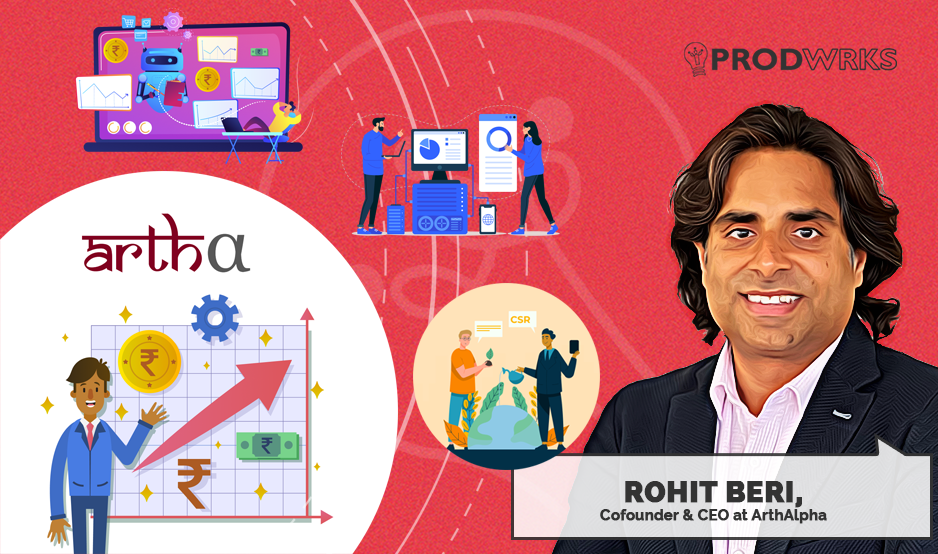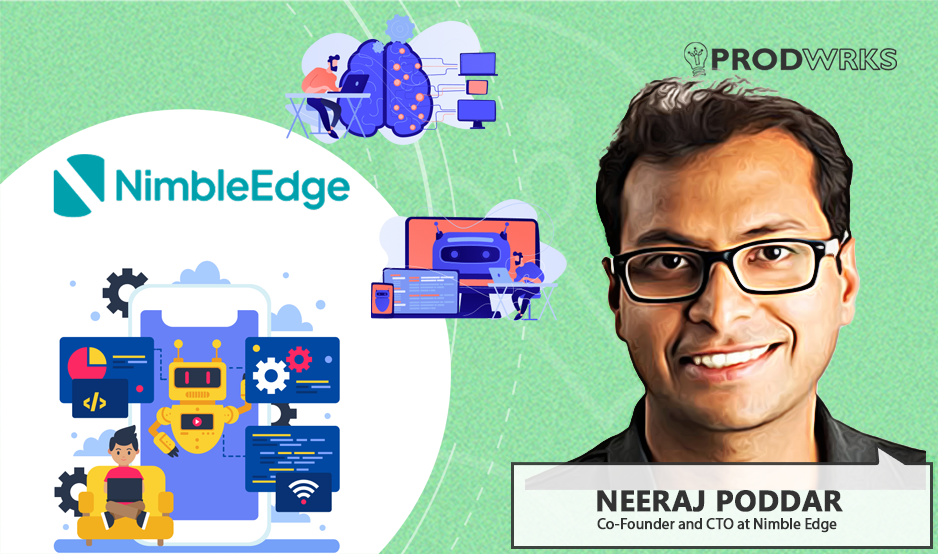
India’s asset management industry is undergoing a quiet transformation. While most of the market is driven by fund managers with traditional strategies, new generation quantitative investment firms are beginning to reimagine how capital is managed, using data and algorithms. Quantitative investing, long dominant in Western markets, is slowly finding its place in Indian portfolios too, now deriving insights with the advancements in AI.
Rohit Beri, co-founder of ArthAlpha, saw the opportunity in AI-driven quant investments early. In his previous stint as the Chief Investment Officer at True Beacon (a company founded by Zerodha’s Nikhil Kamath), Rohit was involved with the launch of a fund called True Beacon Equity Factor Quant, which at that time was India’s first AI-driven quantitative long-only strategy.
“I noticed that the acceptance of quant strategies and technology in investing had grown. People are far more open to these ideas now and willing to have meaningful conversations,” Rohit explains.
Convinced that India’s markets were ready for AI-driven quant investments, Rohit Beri launched ArthAlpha with co-founder Rohit Kumar Jha. ArthAlpha is a Bengaluru-based licensed portfolio management service (PMS) platform built on top of their proprietary AI-driven investment strategy and research. The firm sits at the intersection of finance, technology, and behavioral science, using an interdisciplinary approach to decode the noise of financial markets.
With their flagship investment strategy via Machine Learning driven Equity Quant (MEQ), the firm is hoping to show that the future of Indian investing might be powered not just by star fund managers and gut instincts, but by machine logic and AI.
How ArthAlpha Builds Its AI-Driven Investment Strategy
The core of ArthAlpha’s business lies in building a technology platform for quantitative investment research powered by Machine Learning driven Equity Quant (MEQ). ArthAlpha monetizes this technology by running a portfolio management business on top of it while taking an interdisciplinary approach to investing.
As per the company website, MEQ is an investment strategy combining fundamental analysis with data science to make investment decisions. MEQ is a high churn strategy that continuously evaluates every stock in the investible universe to determine optimum allocation to generate significant excess returns over the index, while benchmarking itself against S&P BSE500 TRI in the medium to long term.
Rohit explains, “We bring four different branches of knowledge together to make investment decisions. We call it our four pillars.”
ArthAlpha’s first pillar is fundamental analysis, but approached through code rather than manual research. The team models the same factors traditional investors care about: growth, valuation, governance, but does it at scale using data and algorithms.
“We look at the same fundamentals as any discretionary investor. The difference is in the tool. Their tool is Excel, ours is Python.”
ArthAlpha’s second pillar is quantitative finance. This means applying financial engineering, econometrics, and time series analysis to ensure every decision is mathematical and objective. The aim is to eliminate bias by relying on formulas that produce the same result no matter who runs them or when.
“We cannot assess management quality based on gut feeling. It has to be a formula. You and I should get the same score for the same stock, whether we run it today or ten years from now.”
The third pillar is data science, focused on artificial intelligence and machine learning, as these models are non-linear and are able to detect complex relationships between variables that traditional statistical methods may miss. This allows for a more detailed analysis of the same data, helping refine investment signals beyond what standard econometric models can capture.
He explains, “We use AI to reduce noise in signals, uncover relationships between factors, and size positions. It also helps us understand how macro and micro conditions interact, so our models adjust to changing market regimes. This makes them more stable and effective across both bull and bear cycles.”
The final pillar is behavioral psychology. The approach is grounded in understanding how emotional and cognitive biases influence market behavior. Human responses like fear and greed often lead to irrational decisions, and these patterns show up in stock price movements.
ArthAlpha uses these insights to build models that track and respond to these patterns, wherein one clear example is herd behavior.
“People invest the most at the peak and withdraw the most at the bottom,” Rohit says. “This cycle repeats in long-term trends and even daily price movements.”
“We’re not trying to outsmart the market. We try to understand how emotions move it,” he says.
A Quant Product Built on Human Behavior, Not Just Market Signals
“We use fundamental analysis, data science, and quantitative finance to understand human stupidity,” says Rohit, chuckling. “And then build models that take advantage of those behavioral biases to make better investment decisions.”
“The starting point for us is simple,” Rohit explains. “Markets should be efficient, but they’re not. That is our opportunity. But to benefit from it, we need to understand why inefficiencies exist in the first place and how they correct over time. That is where human behavior comes in.”
“Most quant firms in India are either doing price momentum or limited multifactor models. They don’t go deep into the behavior that causes inefficiency,” he says. “We’re marrying the AI and quant side with accounting and financial analytics. That combination is rare, especially in India. It lets us build models that are not just smart, but grounded in how investors behave.”
Building for India’s Market Realities, Not Just Global Playbooks
While ArthAlpha’s product draws from established global quant frameworks, the team has made sharp course corrections to adapt to the nuances of the Indian market, where some of the most compelling insights came from data patterns that reveal how India’s markets behave differently from their Western counterparts.
One such discovery was made during the team’s analysis of how and when equity returns are generated.
“Most people don’t realise that a bulk of equity market returns in India come while we are sleeping,” Rohit explains.
“Markets in India, on average, generate a positive return of about 25 basis points overnight each day. During the trading day, they tend to lose about 17 basis points. That was something I didn’t know earlier,” he says.
Another pattern emerged when the team turned its lens toward the value factor. Globally, value is a well-respected quant signal. But in India, Rohit found that value-based strategies often underperform compared to momentum.
Digging deeper, they uncovered a structural reason. With India’s real GDP growth hovering around 6 percent and inflation in the 4 to 5 percent range, nominal economic growth is north of 10 to 12 percent. That inflates the base numbers of all companies.
“Value, as a factor, gets polluted by growth in a high-growth economy like India. If you use it raw, it won’t give you clean signals. You have to adjust for both inflation and growth,” he explains. Once they corrected for this inflation-growth effect, the value factor started to perform meaningfully better in their backtests.
A Focused Client Base of HNIs, Ultra-HNIs, and Family Offices
“If someone has ₹2 crore in total assets and wants to give us ₹50 lakhs, I tell them not to invest with us,” says Rohit. “They’re better off in diversified mutual funds. We don’t think anyone should allocate more than 10 to 15 percent of their capital here.”
The product is built for financially mature users who are high net worth individuals, ultra HNIs, and family offices who understand public market cycles and want structured, math-driven exposure.
Rohit classifies ArthAlpha’s clientele into three different categories:
Wealth managers: ArthAlpha works with wealth managers in a B2B2C format, where they pitch ArthAlpha’s products to their clients.
Direct relationships: With family offices and seasoned investors.
Inbound interest: From investors who discover ArthAlpha through media, social media, or newsletters and reach out with informed questions.
“It’s not a mass-market product,” Rohit says. “We’re looking for users who know what they want and ask sharp questions.
A Business Built on Talent, Infrastructure, and Relentless Research
“Finding talented people who want to work at a young, unknown startup is tough,” Rohit says. These are individuals who already have jobs at some of the best firms in the world. Convincing them to take a bet on us was a challenge we faced.”
“Setting up the infrastructure was expensive,” Rohit says, referring to the systems required to run large-scale models. That hurdle was cleared early when DSP came on board as an institutional investor, giving them the backing to build the computing stack their vision demanded.
“Whatever we run today, we know will become obsolete. If we're lucky, in a year. If not, maybe even in a month,” Rohit says. “So we’re always testing, always improving.”
ArthAlpha’s Pricing Model
“There are three models we offer, depending on the type of investor,” Rohit says.
The most straightforward is a 1.5% management fee, paired with a 15% performance fee applied only to returns above a 10% hurdle.
A second option replaces the fixed hurdle with a benchmarked one. Here, the client is charged 25% of any alpha generated above the Nifty 500 index. The third model is more customized, with a lower management fee but a quarterly performance fee set at roughly 35% of the excess return generated above the benchmark.
“We don’t believe in fixed-fee models,” Rohit says. “Our view is that if we want to deliver consistent long-term returns, our interests have to be aligned with the investor’s.”
“If we fix our fees, we remove the incentive to perform. We become just another asset manager. And that’s not the business we want to build,” he adds.
“The very first clients were friends, former colleagues, and early backers who knew what we were building,” he says.
How ArthAlpha Measures If It’s Working
ArthAlpha tracks a combination of metrics depending on the context. At a business level, standard measures apply: revenue growth, client retention, and profitability. But at the product level, the focus shifts to a different set.
The core idea is to isolate performance driven by investment skill from performance driven by market movements. To do that, the team tracks alpha, the return generated above what the market delivered, and the Information Ratio, which adjusts that risk return. This is the same metric SEBI made mandatory for PMS firms only recently, though Rohit says he has used it since his days abroad.
“Our job is to generate alpha,” he says. That becomes the bar across the team, and a check on whether the research is moving in the right direction.
The Reality Behind AI-Driven Investing
“People think AI means magic,” he says. “But 90% of the job is just dealing with data. Understanding it, cleaning it, and figuring out where the gaps are. Only then can you apply models with any real intelligence.”
“Everyone wants to build the next AI-driven fund,” he says. “But very few want to spend a year just figuring out why their signals are breaking.”



